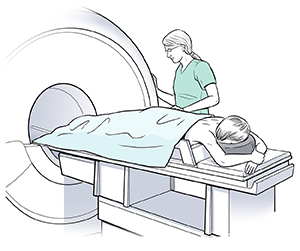Magnetic Resonance Imaging (MRI) of the Breast
Magnetic resonance imaging (MRI) of the breast is an imaging test. It uses strong magnets and radio waves to make pictures of the inside of the breast. It also makes images of the tissues around the breast. Breast MRI is used to check for problems, such as a leaking breast implant or a lump or growth. In some cases, such as people with high risk for breast cancer, a breast MRI may be used along with a mammogram to view breast tissue. It can show kinds of tissue that mammograms can't. It can be used to guide breast biopsies that can't be done by other methods. It can help with diagnosis and management. Most MRI tests take 30 to 60 minutes. Depending on the type of MRI you are having, the test may take longer. Give yourself extra time to check in.
 |
| During a breast MRI, you lie face down on a platform that slides into a tubelike machine called a scanner. |
Before your test
-
Follow any directions you are given for taking medicines and for not eating or drinking before the test.
-
Follow your normal daily routine unless your healthcare provider tells you otherwise.
-
You’ll be asked to remove your jewelry, watch, hearing aids, credit cards, pens, eyeglasses, and other metal objects.
-
You may be asked to remove your makeup. Makeup may contain some metal.
What to know
MRI uses strong magnets. Metal is affected by magnets and can distort the image. The magnet used in MRI can cause metal objects in your body to move. If you have a metal implant, you may not be able to have an MRI unless the implant is certified as MRI-safe. People with these implants should not have an MRI:
The radiologist or technologist may ask you if you:
-
Have had stereotactic breast biopsy
-
Have a pacemaker or implanted cardiac defibrillator
-
Have an artificial body part (prosthesis)
-
Have metal rods, screws, plates, or splinters in your body
-
Wear a medicated adhesive patch
-
Have tattoos or body piercings. Some tattoo inks contain metal.
-
Have implanted nerve stimulators or medicine-infusion ports
-
Work with metal
-
Have braces
-
Have a bullet or other metal in your body
-
Have had an eye injury involving a metal object
Tell the radiologist or technologist if you:
-
Are allergic to any medicines
-
Are pregnant or think you may be pregnant
-
Are afraid of small, enclosed spaces (claustrophobic)
-
Have had past surgeries
Tell your healthcare provider and the technician if you:
-
Have ever had an imaging test, such as MRI or CT with contrast dye
-
Are allergic to contrast dye, shellfish, or any medicines
-
Have a serious health problem. This includes diabetes or kidney disease, or a past liver transplant. You may not be able to have the contrast material used for MRI.
-
Are pregnant or may be pregnant, or are breastfeeding
During your test
-
You may be asked to wear a hospital gown.
-
You may be given earplugs to wear if you choose.
-
You may be injected with contrast dye through an IV line in your hand or arm. This is a special dye that helps to find out if an area of the breast could be cancer (malignant). You may need this, depending on the reason for your exam.
-
You’ll lie on a platform that slides into a tube-like machine called a scanner. You’ll be on your stomach with your breasts placed through openings in the platform.
-
Remain as still as you can while the camera takes the pictures. This will make sure to result in the best images.
After your test
-
You can get back to normal activities right away, unless told otherwise by your healthcare provider.
-
If you were given contrast, it will pass naturally through your body within a day.
-
Drink lots of water so that the dye passes quickly out of your body.
Getting your results
Your healthcare provider will discuss the test results with you during a follow-up appointment or over the phone.
Online Medical Reviewer:
Jessica Gotwals RN BSN MPH
Online Medical Reviewer:
Neil Grossman MD
Online Medical Reviewer:
Raymond Turley Jr PA-C
Date Last Reviewed:
12/1/2022
© 2000-2025 The StayWell Company, LLC. All rights reserved. This information is not intended as a substitute for professional medical care. Always follow your healthcare professional's instructions.